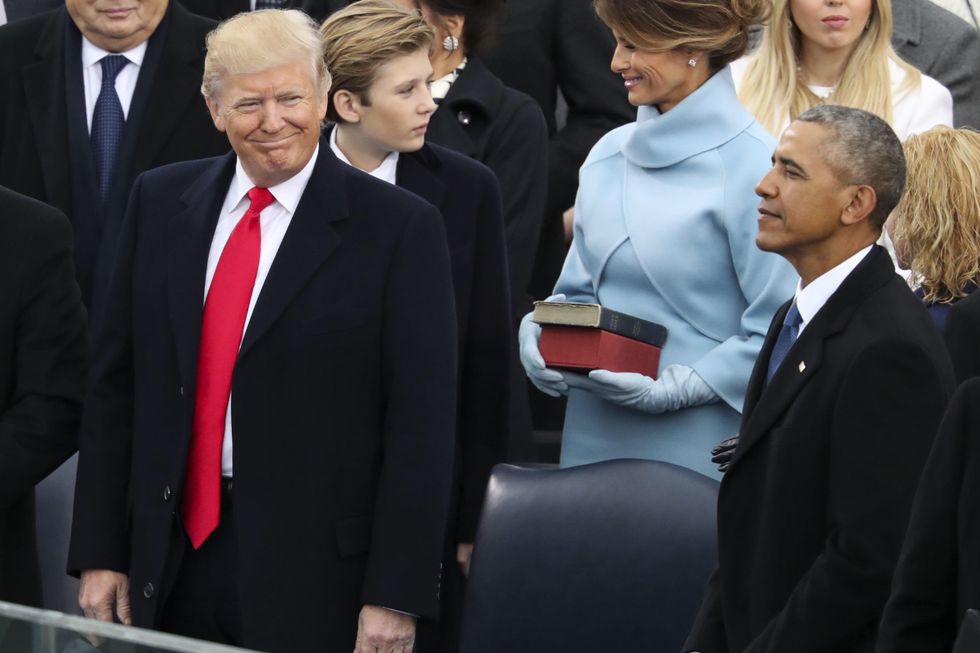
President-elect Donald Trump looks over at President Barack Obama before being sworn in as the 45th president of the United States during the 58th Presidential Inauguration at the U.S. Capitol in Washington on Friday. (AP Photo/Andrew Harnik)

As President Barack Obama leaves the White House and the Trump administration begins its work, much could be said about Obama’s economic legacy.
Under Obama, 14.5 million people have left the labor force, many of them because they’ve been unable to find or keep good jobs. Average annual food stamp enrollment is up by 16 million since 2008. Premiums for benchmark health insurance plans sold on the Affordable Care Act exchanges increased by an average of 25 percent compared to 2016. Home ownership is at its lowest point since at least 1995, the earliest year recorded in the Census Bureau’s most recent report. The cost of a full-time undergraduate’s tuition, fees, and room and board at a four-year college rose by 25 percent over Obama’s time in office, and outstanding student loan debt now tops $1.4 trillion, which is more than all outstanding credit card or auto loan debt.
But of all the problems facing President Trump, the nation’s debt crisis might be the worst of them. Since Obama was sworn into office, about $10 trillion has been added to the national debt, more debt than under any other presidential administration in history. There are a variety of reasons this occurred. Obama spent more on discretionary programs, passed an $830 billion stimulus package (the American Recovery and Reinvestment Act), entitlement programs have expanded and the population has aged, and government tax revenues fell dramatically immediately after the 2008 crash.
Not all these problems can fairly be attributed to Obama’s administration; plenty of the blame belongs to George W. Bush and the reckless spending of both the Democrat- and Republican-led Congresses of the 2000s. But it was Obama’s responsibility to manage the budget, fix entitlements, and control spending while he was in office, none of which were accomplished. Instead, he spent wildly, printed trillions of dollars to prop up the failing economy, and implemented policies that stunted economic growth. Because of the incredible amount of debt added under Obama, I believe we are worse off today than we were during the height of the so-called Great Recession.
Adding massive amounts of debt is fiscally irresponsible and dangerous for a number of reasons. As we continue to add more debt, the percentage of the budget that must go toward paying that debt back will grow larger and larger. In 2016, the cost of net interest payments made by the federal government reached $241 billion, more than what was spent on veterans and homeland security or education, labor, housing, and transportation. Even without any new spending or tax cuts, the Congressional Budget Office (CBO) predicts interest payments are expected to rise to $712 billion by 2026, which is $133 billion more than what we currently spend on defense and $347 billion more than the current cost to the federal government for Medicaid.
Ballooning interest payments mean taxpayers will have to pay significantly more of their incomes to offset these costs, the federal government will have to issue even more bonds (thereby going even deeper into debt), or both. The problem with issuing more bonds is as the country adds more debt, even fewer foreign countries and private investors will want to buy government bonds, because the likelihood of being paid back (with interest) becomes exponentially lower as more debt is added. The only way for the government to survive at that point is to sweeten the deal by increasing interest rates to encourage investors to buy the bonds, but that will inevitably lead to even higher interest payments, thereby worsening the cycle of debt.
The CBO believes such a scenario, which it predicts to occur based on the current situation, would mean the “likelihood of a fiscal crisis in the United States would increase.”
The only other option would be for the further printing of money through actions by the Treasury Department and the Federal Reserve Banks. Such a scenario, while likely, is also incredibly dangerous, because it undermines the credibility of our currency, discourages saving and investment, and, perhaps most importantly, could eventually lead to the rest of the world deciding to dump the dollar in favor of a new currency.
Currently, the dollar is used for many important international transactions, but China, Russia, and other world leaders have made it clear over Obama’s time in office they would like to transition away from the dollar to something they believe would be more stable. If this were to occur, the United States would face an economic collapse unlike anything we’ve seen in at least a century. Trillions of dollars could come pouring back into America from overseas, causing rapid inflation and devaluation. Even worse, the Federal Reserve would effectively be forced to swiftly raise interest rates, which would cause an even greater financial collapse, as lending and financial investment dry up.
President Donald Trump certainly has his work cut out for him. If he implements pro-growth economic policies, reduces unnecessary regulations, encourages domestic energy development, and passes balanced or near-balanced budgets, the United States might be able to grow its way out of the current debt crisis. If he continues the Bush-Obama debt legacy, however, America could be in store for another Great Depression.
Justin Haskins (jhaskins@heartland.org) is executive editor of The Heartland Institute.
Justin Haskins